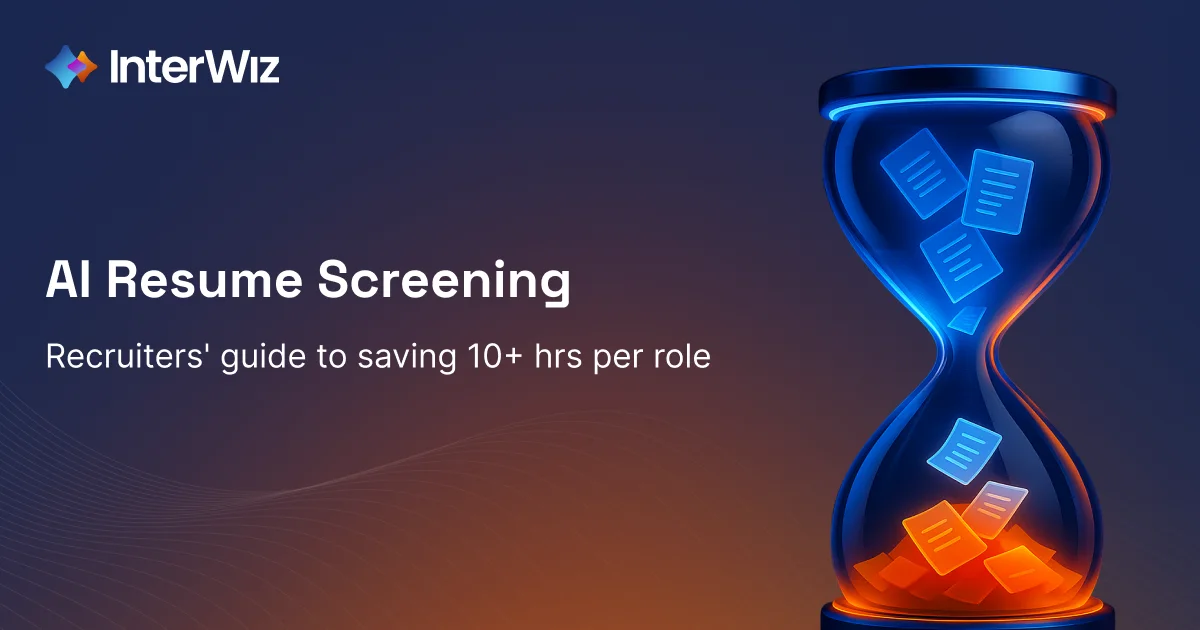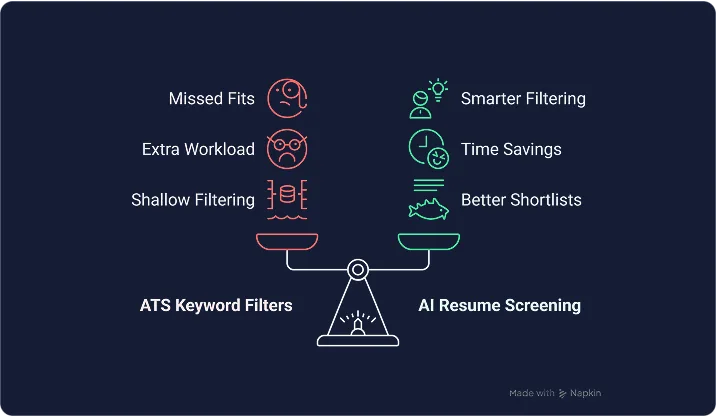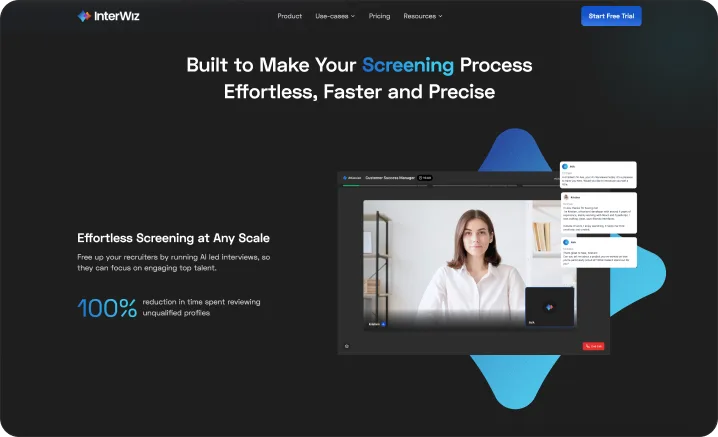JUMP TO SECTION
Data-Driven Hiring | Hiring Best Practices
AI Resume Screening: How Recruiters Save 10+ Hours per Role

Resume screening eats more recruiter hours than any other step. Sorting hundreds of resumes often takes 10 to 15 hours per role, yet most of that effort goes into repetitive checks that add little hiring value.
AI resume screening changes the equation. By parsing resumes, matching skills to job descriptions, and ranking candidates, it produces a ready-to-review shortlist in minutes instead of days. Recruiters routinely save more than 10 hours per role.
The payoff is clear: faster hiring cycles, fewer candidate drop-offs, and more time for high-value work like candidate engagement and decision-making.
This article breaks down where those hours are saved, how the technology works, and what recruiters should know about fairness and compliance.
Key Takeaways
AI resume screening saves over 10 hours per role by automating parsing, ranking, and repetitive admin tasks.
ATS keyword filters can’t match AI’s contextual analysis, which delivers higher-quality shortlists and reduces wasted review time.
The right solution balances speed, compliance, and recruiter adoption, ensuring efficiency scales without sacrificing fairness or candidate experience.
How AI Resume Screening Saves Recruiters Over 10 Hours per Role
The most time-consuming part of the hiring process is screening resumes of hundreds of applicants. This manual effort not only frustrates recruiting teams but also takes up the precious time of technical leads, engineering managers, and development teams. AI resume screening saves recruiters more than 10 hours per role by automating the screening process and filtering out the most suitable candidates in minutes.
Let's take a look at how manual screening delays are resolved through AI hiring tools:
The Manual Screening Bottleneck
Manual resume review is a slow and linear process. Recruiters spend 6–30 seconds on an initial skim and 3–5 minutes on profiles that appear promising. For a pool of 200 applications, even a conservative three-minute pass per resume equals 10 hours of work. Adding sorting, documenting notes in an applicant tracking system, and sending status updates increases the total to 12–18 hours per 100 resumes.
Solution: How AI Screening Compresses the Process
AI screening tools automate these steps that drain recruiter time:
Instant parsing and analysis: With AI-powered filtering, thousands of resumes are scanned in parallel within minutes.
Objective shortlisting: Predefined criteria generate ranked candidate lists, cutting hundreds of resumes to a select few. For recruiters, that means less guesswork and more confidence in who makes it to the next round.
Automated admin tasks: Candidate communication and interview scheduling can be handled automatically, eliminating hours of back-and-forth.
The Combined Effect: Simple Math
The impact becomes clear in a side-by-side comparison:
Manual screening (100 resumes): ~10 hours
AI screening (100 resumes): ~1 hour
Time saved (per 100 resumes): ~9 hours
For roles with 200+ applicants, recruiters routinely save well over 10 hours per position. Here’s what this means: staffing agencies and HR leaders can reallocate time from repetitive filtering to high-value tasks like candidate engagement and structured interviews.
AI Resume Screening vs ATS Keyword Filters: Which Saves More Time?
AI resume screening saves recruiters significantly more time than ATS keyword filters, as it goes beyond keyword matching to deliver context-driven shortlists. While both tools aim to cut workload, their methods and results are very different.

Take this common scenario as an example: A candidate’s resume reads, “Software engineer with 5 years of experience building production-ready applications in Python and Django. Designed scalable APIs, mentored junior developers, and contributed to large enterprise systems. Completed a short online course in JavaScript.”
How would each system handle this profile?
Where ATS Keyword Filters Fall Short
A keyword-based ATS may miss this candidate if the job description asks for a “backend software engineer”, because the resume doesn’t use that exact phrase. Instead, filters only catch preset terms like “backend developer,” “full-stack,” or “Python developer.” As a result, qualified applicants can be excluded too early.
At scale, this creates three problems for recruiters:
Missed fits: Strong candidates are rejected for wording mismatches.
Extra workload: From 200 resumes, an ATS might eliminate 50 but still leave 150 for manual review (~7–8 recruiter hours).
Shallow filtering: Recruiters must still dig through large pools to separate qualified from unqualified.
How AI Resume Screening Changes the Equation
An AI screening tool evaluates context, not just words. In this case, it sees “built production-ready applications in Python and Django” as evidence of real expertise, while recognizing the JavaScript course as secondary. That nuance highlights the candidate as a strong fit, even without an exact job title match.
At scale, recruiters see three clear advantages:
Smarter filtering: AI screening tools interpret how skills were applied, not just if keywords appear.
Time savings: From 200 resumes, AI can narrow the list to 20–30 high-fit candidates, leaving ~1–1.5 hours of review time.
Better shortlists: Recruiters spend less time on irrelevant profiles and more time with strong candidates.
This means recruiters move from sifting through 200 mixed-quality resumes to engaging directly with 20 top candidates, turning resume screening from a tedious filter into a productivity advantage.
Choosing the Right AI Resume Screening Solution
The AI resume screening market is crowded, and not every tool delivers equal value. For recruiters and HR leaders, the real question isn’t who has the most features, but which solution makes hiring faster, fairer, and easier to manage at scale.

1. Can the AI System Deliver Accuracy and Reliability?
The first test is whether the AI system can consistently parse resumes and realistically rank candidates. Advanced platforms utilize natural language processing to read skills in context, distinguishing between someone who “attended a Python course” and someone who “built production systems in Python.” Without this precision, promised time savings vanish.
2. Does It Support Fairness and Compliance?
With regulations tightening, bias safeguards are essential. Strong solutions anonymize sensitive data, conduct regular bias audits, and explain candidate scoring within the broader recruitment process. Beyond avoiding legal risk, compliance builds trust with candidates and protects your employer brand.
3. Will It Fit Smoothly Into Your Workflow?
Integration is non-negotiable. A tool should seamlessly connect with your ATS or HRIS, automatically sync data, and extend automation to scheduling or candidate communication. This ensures efficiency gains carry through the entire hiring process, not just resume review.
4. Will Recruiters and Candidates Actually Use It?
Even the best technology fails if recruiters resist it. Intuitive design, quick onboarding, and responsive vendor support are critical. Candidate-facing features also matter: timely updates and transparent processes create a smoother experience and reflect positively on the organization.
A Simple Evaluation Framework
When comparing vendors, keep the focus on three recruiter-first questions:
Does it save measurable time without reducing quality?
Does it meet compliance standards and limit bias risk?
Will my team and candidates actually use and trust it?
If the answer to all three is yes, you’ve likely found a solution that fits. For staffing agencies, that means fewer wasted hours, stronger client confidence, and a hiring process built to scale.
Discover How InterWiz Transforms AI Resume Screening for Modern Hiring
AI resume screening is only the first step. InterWiz takes it further by combining fast, accurate resume parsing with structured interviews and decision support, turning screening into a foundation for stronger hiring outcomes.

Key Capabilities Recruiters Can Leverage
AI-powered parsing and ranking: Extracts and structures candidate data across formats, delivering a ready-to-review shortlist.
Structured AI-led interviews: Standardizes evaluations with customizable templates for technical, soft-skill, and language assessments.
Automated scheduling: Syncs directly with calendars to eliminate back-and-forth coordination.
Transcripts and analytics: Provides interview transcripts, performance data, and ranked results recruiters can trust.
Why This Matters for Hiring Teams
Staffing agencies: Scale high-volume hiring without sacrificing candidate quality.
HR leaders: Make defensible, data-backed decisions that align with fairness and compliance standards.
Recruiters: Reclaim hours from manual screening while gaining deeper insight into candidate potential.
Here’s what this means: by addressing both efficiency and accuracy, InterWiz shifts resume screening from a narrow filtering task into a scalable, end-to-end hiring advantage.
Ensuring Fairness and Compliance in AI Resume Screening
AI screening delivers speed, but without safeguards, it can also replicate existing inequities or expose companies to legal risk. Recruiters need assurance that efficiency does not come at the expense of fairness.
Where Risks Arise
Historical bias: If past hiring data reflects an imbalance, AI tools can learn and reinforce those patterns. A well-known example is Amazon’s discontinued tool that penalized resumes containing the word “women’s.”
Proxy bias: Even if protected data (like gender or race) is excluded, the AI hiring tools may infer bias from proxies such as ZIP code or college name. For recruiters, this creates hidden risks that could undermine diversity goals and compliance.
Disability bias: Some AI hiring tools may mishandle accessible resume formats or penalize non-linear career paths, raising risks under the ADA.
Guardrails Recruiters Should Demand
Regular bias audits: Independent or third-party audits validate that candidate pass rates are consistent across demographics. New York City law already requires these audits for AI hiring tools.
Human oversight: Recruiters remain responsible for reviewing AI-generated shortlists and adjusting when patterns suggest imbalance. Automation should guide decisions, not make them alone.
Transparency and communication: Systems should clearly indicate which skills or experiences influenced the rankings. Candidates should also be informed when AI screening is used, aligning with GDPR and other regulations.
Data privacy controls: AI screening tools must minimize data collection and follow strict retention policies. GDPR and EEOC guidance hold employers accountable, even when using third-party vendors.
Vendor due diligence: Evaluating the fairness and compliance practices of these AI tools is critical. Employers are liable for bias regardless of whether it comes from AI tools used internally or externally.
Getting Started With AI Resume Screening
Adopting AI resume screening is most effective when approached as a structured pilot. These five steps keep implementation practical and low-risk:

Define your goals: Decide whether your priority is reducing time-to-hire, handling high applicant volumes, improving diversity, or speeding up candidate communication. Clear goals make ROI measurable.
Select the right tool: Choose an AI screening tool that delivers accurate parsing, transparent candidate ranking, and seamless ATS integration.
Pilot with one role: Start with a single high-volume role. Define objective screening criteria, then compare AI-generated shortlists against manual reviews.
Monitor and refine: Track time saved, shortlist quality, and candidate experience. Run bias audits to ensure outcomes remain fair.
Keep humans in the loop: Use AI screening tools to automate repetitive screening, but maintain recruiter oversight for cultural fit, motivation, and final decisions.
A pilot-driven approach demonstrates value quickly, helping staffing agencies and HR leaders scale AI screening with confidence.
AI Resume Screening Metrics: What Recruiters Should Track
The value of AI resume screening isn’t proven by claims; it’s proven by metrics. By monitoring efficiency, quality, cost, and fairness, recruiters can connect hours saved to measurable business outcomes.
1. Efficiency Metrics
Time-to-screen: How long it takes to generate a shortlist compared to manual review. This shows direct hours saved.
Time-to-hire: Track the reduction in days to fill a role once AI tools are integrated. Faster hires reduce vacancy costs.
Time to first response: Measure how quickly applicants receive acknowledgment or updates after applying. Shorter response times improve candidate experience and reduce early drop-offs.
Applicant-to-interview ratio: Measures whether the AI screening tool is surfacing stronger candidates earlier, lowering the number of resumes needed per interview.
2. Quality Metrics
Qualified shortlist rate: Percentage of AI-screened candidates who move to interviews. High rates signal accurate matching.
Quality of hire: Measured through first-year retention, hiring manager feedback, or performance scores. Stronger hires prove AI accuracy extends beyond the recruitment process.
Candidate experience: Faster responses and transparent communication boost satisfaction scores and employer reputation.
3. Cost Impact Metrics
Cost per hire: Track reductions in sourcing and screening expenses. AI resume screening cuts recruiter hours, lowering both internal costs and reliance on external agencies.
Vacancy cost savings: Faster hiring reduces the financial impact of unfilled roles on productivity and revenue.
4. Fairness and Compliance Metrics
Diversity impact: Track selection rates across demographic groups to ensure no adverse impact.
False positives/negatives: Monitor when unqualified candidates are advanced or strong candidates overlooked. Lower rates mean higher trust in the system.
Transparency checks: Recruiters should be able to clearly explain why a candidate was ranked highly. This transparency is essential for audits and building trust with candidates.
Together, these metrics show more than hours saved. They demonstrate how AI resume screening improves efficiency, reduces costs, raises hiring accuracy, strengthens fairness, and delivers ROI recruiters can defend in front of leadership.
Bottom Line: AI Resume Screening Beyond Time Savings
AI resume screening is no longer just about saving recruiters 10+ hours per role; it’s about transforming how hiring decisions are made. By pairing speed with accuracy, compliance, and candidate trust, it turns resume review from a repetitive filter into a strategic advantage. InterWiz pushes this further, carrying efficiency into structured interviews and decision support, giving staffing agencies and HR leaders the power to hire faster, smarter, and at scale without losing quality.
FAQs about AI Resume Screening for Recruiters
How accurate is AI resume screening?
Modern AI tools achieve parsing accuracy above 90% and rank candidates contextually, not just by keywords. Accuracy improves further when recruiters calibrate screening criteria and run regular audits.
Will AI replace recruiters?
No, AI handles repetitive tasks like parsing and shortlisting, but recruiters remain essential for candidate engagement, cultural fit assessments, and final hiring decisions.
How does AI improve candidate experience?
By reducing response times and automating updates, AI ensures candidates aren’t left waiting weeks for feedback. A faster, fairer process improves employer branding.
Can AI introduce bias into hiring?
Yes, if unchecked. That’s why regular bias audits, transparent scoring, and human oversight are critical. Properly managed, AI can actually reduce bias compared to manual screening.
What if my applicants use unusual formats or non-standard resumes?
Advanced AI parsers can process PDFs, docx resume files, and even scanned images. Multilingual and non-standard resumes are increasingly supported, though recruiters should always validate edge cases.

High Quality Screening with AI Interviews
Automated interviews built for speed, scale, and accuracy.
🔥 Full features, no credit card required.